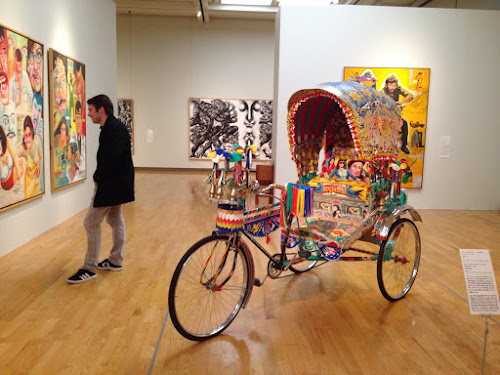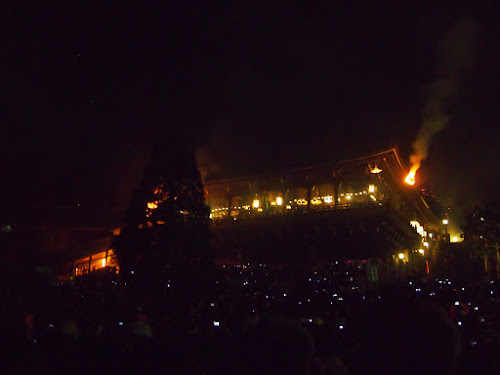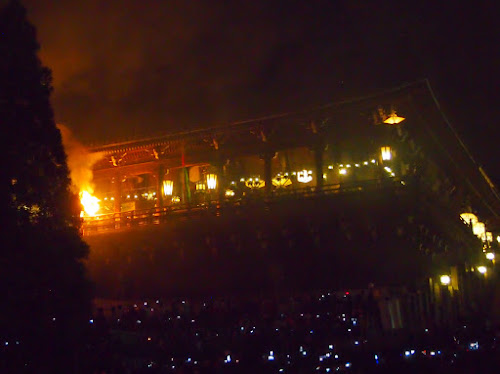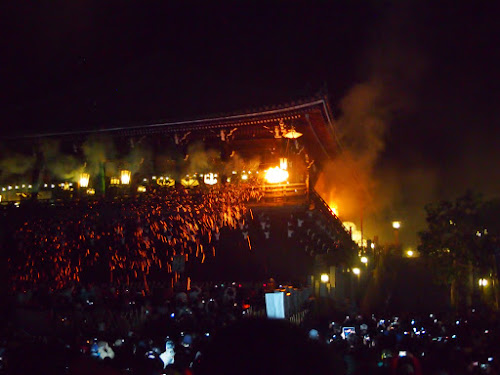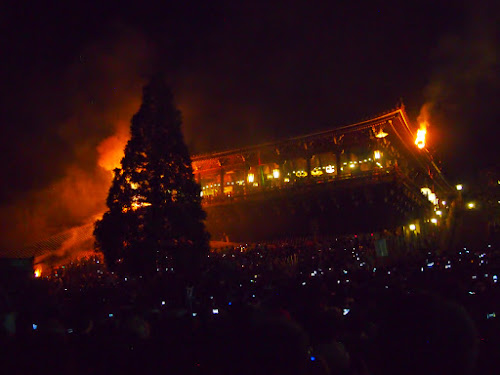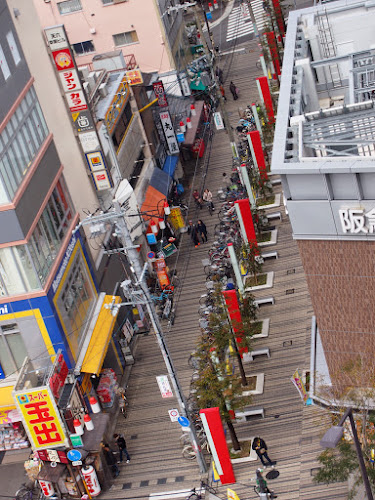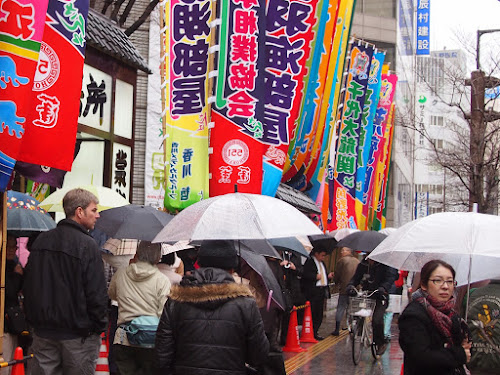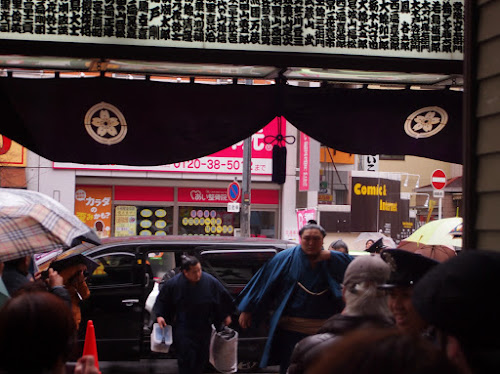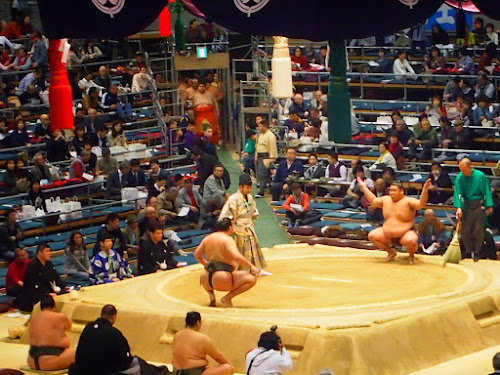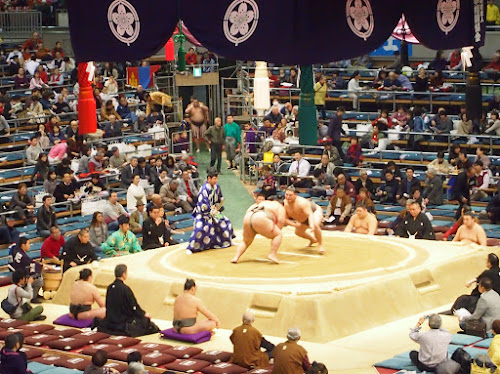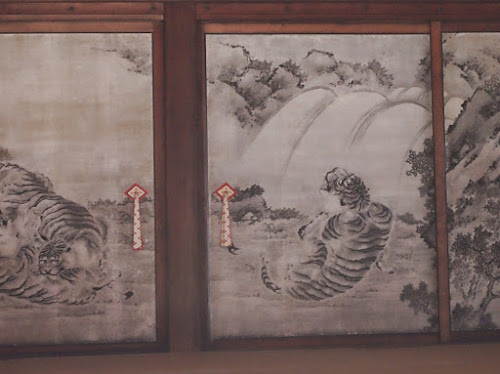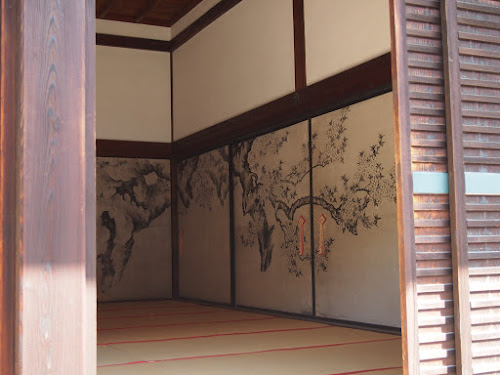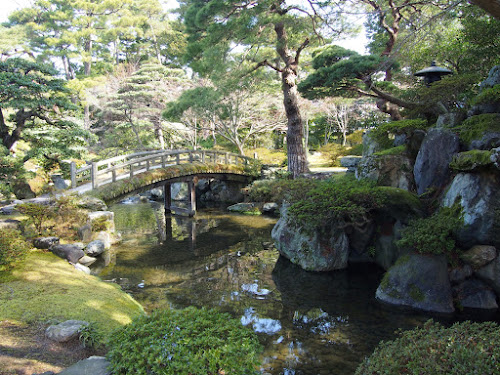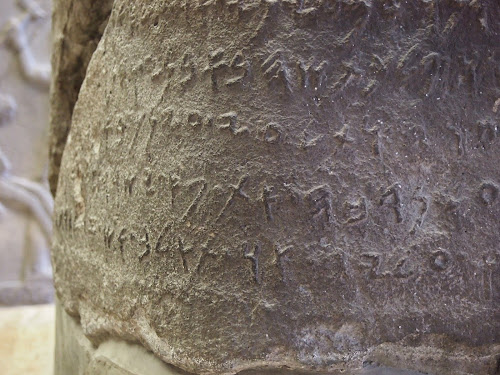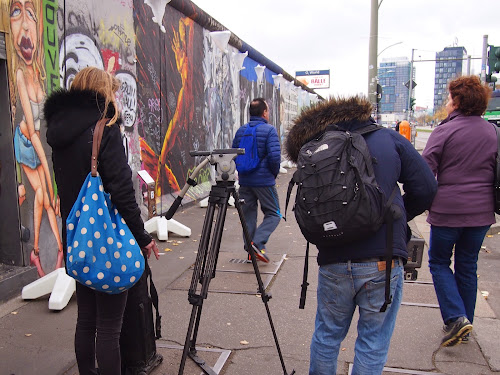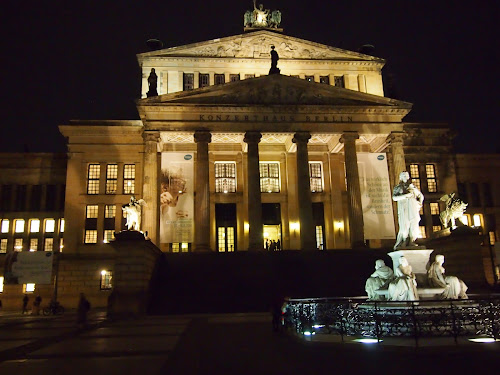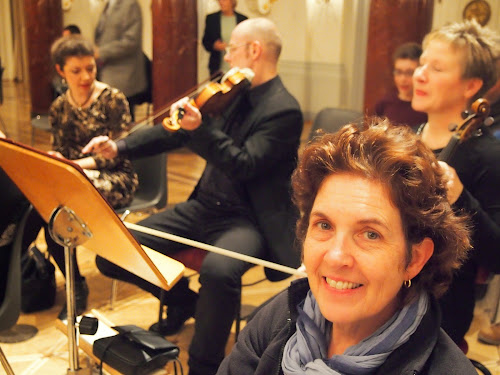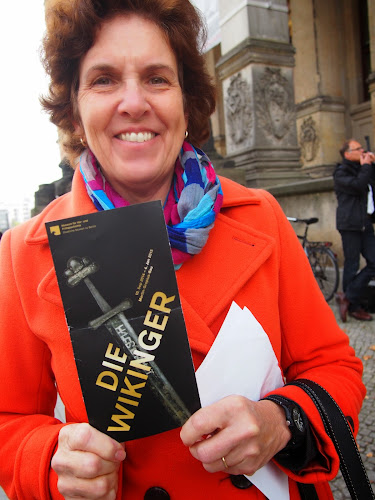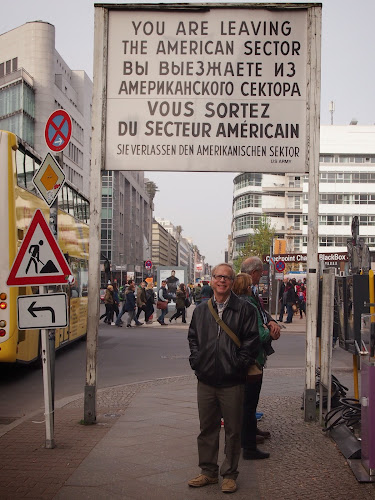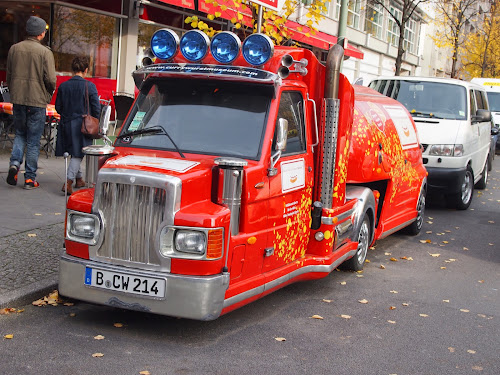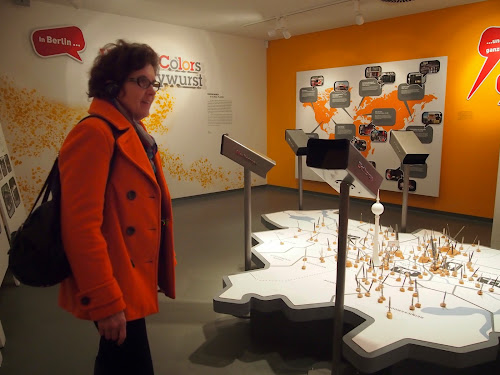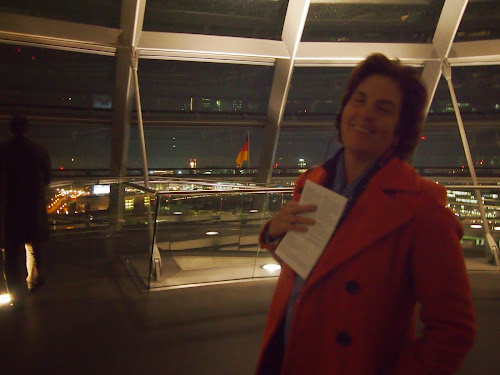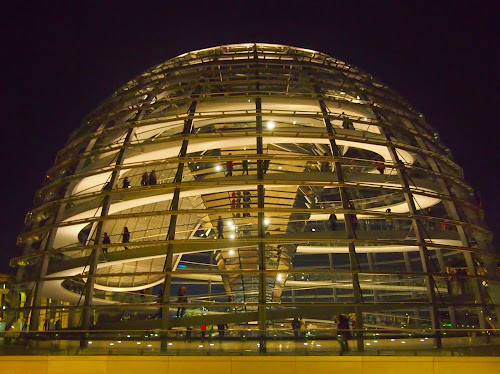Category: Uncategorized
Asian Art Museum, Fukuoka
Fukuoka – as the gateway to Kyushu – is also a gateway to Asia for Japan, with important connections by sea. The Asian Art Museum is dedicated to the art of contemporary Asia. We were drawn to the works we wouldn’t equally expect to see in Berlin or New York. To us, they were the most interesting and appealing.
Otaimatsu at Nara
The Temple precinct of Nara feels like the ancient capital it is, well-worn and burnished by time. Up a slope within the Temple complex is Nigatsudo Hall.
We came to experience a unique Buddhist ceremony. Eleven monks come to stay at the Temple to pray for peace and cleanse the world of sin. Bamboo poles are donated to the temple and the donor’s names are written on them. These poles are then transformed into torches with baskets attached to one end ready to be ignited for the ceremony.
Awaiting the night, people stand or kneel at the foot of the hall in the hope that sparks soon to come will land on them and protect them for the coming year. Upon the conclusion of the festival spring will have arrived. In preparation, workers with water tanks on their backs wet down the sides of the wooden structure and the slope just above the onlookers. Fire has destroyed quite a few temples in Japan, although they are quickly and faithfully rebuilt.
After the ceremony the crowd goes up the steps and into the Hall, looking for bits of ashes to improve their prospects for the year . . .
Deep in Osaka
Weirdly Wonderful
Kabuki! Men dressed in elaborate kimonos with extravagant makeup. Musicians playing the shamisen, flutes, drums, and an assortment of other instruments. Singers with a sound like cante flamenco, bending their tone in and out of tune. Extravantly stylized, but exquisitely expressive, acting and mime. Speaking voices modulated to an extreme, so much so that the limits of the human throat seem to be approached. Fable-like story lines. These are the elements of Kabuki and they are strangely compelling when all put together.
So, the four of us ventured into Kyoto to see it live and with good seats. As the time for the performance approached, the atmosphere became more surreal as uniformed young women intoning a warning chant-like against the use of photography or recording devices worked their way up the aisles, as a wood block sounded seemingly at random.
We were able to follow the stories reasonably well thanks to plot synopses in a booklet with the bios of all the actors, including this gentlemen who played a young woman who succeeded in outwitting the hermit so the dragon could be unleashed and the drought brought to an end, or something like that.
Back in Japan
We’re back in Japan to visit Kyle & Ai.
Since it was a work day for Ai, we headed into Kyoto with Kyle for a tour of the Imperial Palace.
Even though it was a brisk day in Kyoto, we learned there were another 9 1/2 inches of snow back home. It was here in Kyoto that Shogun Tokugawa turned over power to Emperor Meiji in 1868, ending Kyoto’s 1,000 years as the capital of Japan when the Emperor moved his capital to Tokyo.
The main ceremonial building of the palace complex is the Shishinden, where enthronement ceremonies took place. When Emperor Akihito acceded to the throne in 1989, the Imperial thrones were flown by helicopter to the Imperial Palace in Tokyo.
The feet of the Emperor at Kyoto never touched the ground. The Seiryoden was the Emperor’s residence. He would sit on raised tatamis to receive people and retreat to the tent behind when he tired. If he left the building he would be carried.
Of the 1,800 paintings in the Palace, these are a few of the very few that can be seen by the public. They adorn waiting rooms for aristocrats seeking audiences with the Emperor. The lowest order of nobles were assigned to the room decorated with blossomin cherry trees and with red tapes between the tatami mats. The next highest group used the room with cranes and white tapes between the tatamis. The very highest of the nobles waited in the room with white tapes and tigers on the walls. In its adoption by the Japanese, the zodiac retained the tiger even though the only sign of tigers ever having lived in Japan are the fossil remains of prehistoric times. However, the tiger has always been a potent symbol of bravery, dignity and the power to protect.
The Oikeniwa Garden, inside the palace walls, provided a moment of traquil reflection . . .
Berlin: Day Four
We started our day at Kaiser Wilhelm Memorial Church, originally consecrated in 1895 and named by Kaiser Wilhelm II in honor of his grandfather. It was irreparably damaged in a bombing raid in WWII and a modern church has been constructed in four buildings clustered around the ruins. The 1963 construction is undergoing renovation. The figure of Jesus is made of tombak, a metal with which we hadn’t been familiar.
We next visited one of 16 atomic bomb shelters constructed in Berlin in the 1970s. It was intended to house 3600 people for two weeks and there were rooms designed to count people through peepholes so that no more than the allotted number could enter the shelter itself. It would have been insanely cramped and claustrophobic if ever used, not to mention that the 16 shelters would only have housed 1% of Berlin’s population. There were no mirrors so as to discourage suicide and deprive the berserk of potential weapons. The kitchen in the photo would serve 1800 people. Two of the four well water pumps were left as manually operated ones to provide the opportunity for exercise or to vent pent up anger.
After a civilized lunch, a visit to the Kathe Kollwitz museum and some shoes-off time at the hotel, we returned to the Memorial to the Murdered Jews of Europe, an evocative city block near the Brandburg Gate. Our first evening we walked through in the dark. The terrain undulates across the field, so that the blocks vary greatly in height to maintain only slight variations on the visual surface. Jewish people had been deeply woven into the life of Berlin for centuries. Perhaps 10,000 live there now.
For our final dinner in Berlin, we went for sausages – good ones. We were encouraged by the warm smell of a wood fire and sausages being grilled. We weren’t disappointed.
We also returned to the Brandenburg Gate to check out the festivities marking the 25th anniversary of the fall of the Berlin Wall. The balloons lined 10 miles out of the more than 25 miles of death strip that once kept East Germans out of the west. Tonight it was the scene of a party with balloons marking the path of the Wall.
All along the path of the wall, large screens played out scenes from the time when the wall separated families and destinies: scenes like an East German official saying, “If people don’t respect our borders, they will taste our bullets” and footage showing the wide “no man’s land” on the east side of the wall laced with barbed wire and guards on both sides lobbing tear gas canisters at each other.
Berlin: Day Three
A whole area of the Pergamon Museum was just closed – until 2019 – the area housing the famous Pergamon Altar, for which the museum is named. Thank goodness! Otherwise, we’d really be suffering from museum overload. There was enough jaw-dropping material remaining to keep us fully engaged. We’ve included a scant sampling with no real detail (because we’re not taking notes, sorry!).
For a change of pace, we visited the East Side Gallery, an area of the Berlin Wall covered with street art. “The Kiss” between Gorbachev and Honecker is a classic. It was a little more difficult making the trip to see this than expected because one of the train systems was closed due to a strike. Oh, well.
(Full room)
After dinner we walked over to the Konzerthaus to hear Ivan Fischer conducting the Konzerthausorchester Berlin in Schubert’s “Great” Symphony in C Major. Much to our surprise, this was a symphony in the round with audience members interspersed among the orchestra on the floor of the hall. We spoke with the violinist behind us and learned that this was, in fact, the first time they had ever done such a thing. Everyone seemed to enjoy it. We certainly did, although – as one might expect – the balance of instruments was tilted towards whoever sat closest to you. We got a lot of double bass and first violin. Of course, the antiphonal effect was amazing. Fischer gave a talk before each movement and responded to comments on social media at the conclusion. This was all lost on us since it was in German. Directly in front of us, in the press section, a woman was doing what – for want of a better term – we’d call automatic drawing. She had large sheets of paper on her lap and moved a pencil around the paper in response to the music. At times it was as if she were frenetically bowing a phantom instrument. Unfortunately, she didn’t know the score and would get caught up in something that didn’t shift in time with the music. A strange phenomenon to add to our entertainment. All in all, a lot of fun.
Berlin: Day Two
Ah . . . the initial motivation for our trip to Berlin, an exhibit put together by the Danish National Museum, the British Museum and the Martin-Gropius-Bau Museum here in Berlin. As photos were not permitted, words will have to suffice.
As we pointed out in our post from L’Anse Aux Meadow, the Vikings have been reappraised in recent years. They are no longer seen by scholars as merely bloodthirsty debauchers, pillagers, rapists and all-around scoundrels. That was apparently the norm in those days and, in any case, it was their enemies who wrote their history. They are now recognized as having had a well-established and capable society that held sway over a very considerable area for a few hundred years.
They came to control Ladoga in present day Russia and were invited by the Russian princes to establish control over what were fractious Russian tribes, founding what became the Rurik Dynasty of the Kievan Rus’ (see our postings from Russia). They provided the guard to the Byzantine emperors (the Varangian Guard). They founded the first towns in Ireland (and, we’re told, are responsible for the red-headed among the Irish). They, as we all know, established at least one base camp in North America. And, without the Vikings, how could Wagner have written The Ride of the Valkyries? Need we say more?
By the way, we do have one correction to a prior post from Newfoundland. We reported that, according to our Parks Canada interpreter, only one metal Viking helmet had ever been unearthed. We saw three in the exhibit, although we can confirm that they did not have horns. There was one skull with teeth filed down to provide a fearsome impression, but that’s not unique among the world’s peoples. There were also a lot of swords, including Ulfberht swords. These Frankish swords were the best money could buy in the 9th century and were favored by the Vikings. Sometimes their enemies would dig up the graves of Viking warriors just to have the best in modern weaponry.
You just might think there’s a conspiracy to bring the Vikings back to full respectability or perhaps mount a campaign to take over the world in their name when you realize that something you use every day is named after the king who united the Danish tribes and converted them to Christianity. The Bluetooth logo is a combination of the runes used to create the initials of none other than Harald Bluetooth (died 985).
We went next door to the museum built on the site of Gestapo headquarters to become immersed in true evil. The Topographie Des Terrors demands a lot of reading and studying seemingly countless photographs documenting the rise of Hitler and the SS. It is horrifying to see photograph after photograph of both cheering crowds and of people lined up for processing or execution or detention, middle-aged men in suits, some portly and some thin, with their arms raised facing a wall or of village women and children tied to ropes held casually by soldiers pausing for a photo op. A lot of people were making their way patiently and soberly through the exhibits. There were groups of school children and a few foreigners, but mostly Germans reading intently. It makes you wonder whether the rest of us will continue to remember the lessons of the twentieth century.
In front of the Terror museum a block long section of the Berlin Wall has been preserved and we found a preserved East German guard tower near Potsdamer Platz. One grim period followed another, although we are beginning to find opportunities for humor in thinking about the division of the city and of the country until just 25 years ago. In comparison, it is a lesser wound to heal. Nonetheless, the partition of Germany was certainly not a time to recall with affection.
Down the street is Checkpoint Charlie, the most famous crossing point between East and West Berlin during the occupation. It was a frightening place in those days with incredible anxiety on both sides. Many Germans died trying to escape to the west over the wall and this was one of the few ways to make it through without being killed.
Berlin: Day One
At long last, Berlin! Having moved from Europe in 1988, before the fall of the Berlin Wall, we had never visited Berlin. Newly inspired, we decided to take a few days to correct our oversight. And, what better time than the 25th anniversary of German reunification. Here in all it’s nighttime glory is the Brandenburg Gate. Built at the end of the 18th century, victorious armies marched through it up through 1945 when the Soviet Army captured Berlin. The chariot and horses were, along with much of Berlin, destroyed in the war. Fortunately, the molds were found and new statutes cast by the Russians.
As we leave Berlin, there will be major celebrations and we noticed large stages being constructed on the side of the gate away from Unter Den Linden. We got a good look at the extent of it from the Reichstag Dome.
Built at the end of the 19th century, the Reichstag is best known outside of Germany as having been burnt down. In 1933, an arsonist caused major damage to the building and the Nazis used the incident as an excuse to pass very repressive legislation that helped them consolidate power. They rebuilt it, it was destroyed in the war and has been rebuilt yet again. This time, a British architect helped them spiff it up and create a major tourist attraction by adding an amazing glass dome. It features a moving sun shield, a ten meter wide hole in the top for ventilation and a mirrored cone in a passive solar system, and symbolizes the principle that the people are above the government.
The Bundestag, of course, meets in the Reichstag and this is their debating chamber. We, the people, certainly have a dizzying view of democracy at work.






















